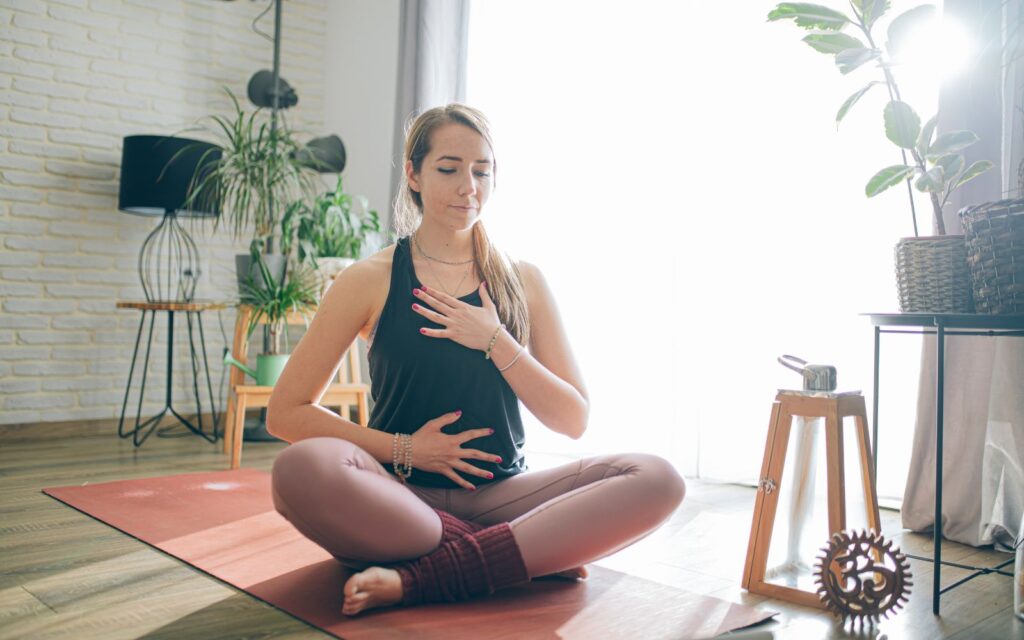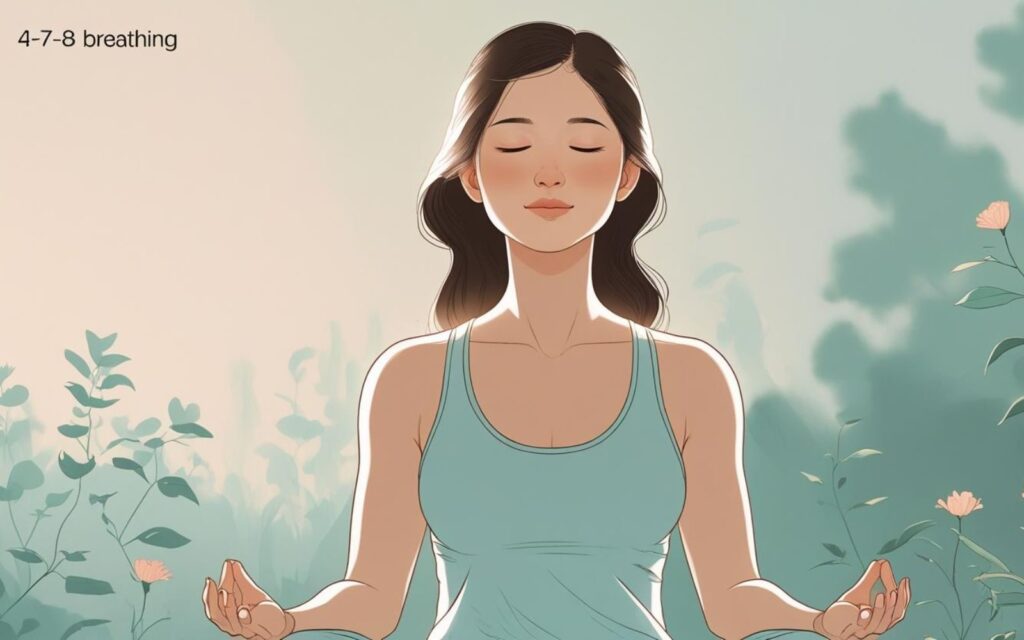Simple Breathing Exercises for Anxiety: Calm Your Mind in Minutes

Feeling stressed or overwhelmed? You’re not alone. Anxiety can trigger a rapid heartbeat, shallow breathing, and even panic attacks.
But the good news is that simple breathing exercises for anxiety can help you regain control, relax your nervous system, and feel calmer.
Breathing exercises work by slowing down the breath, activating the parasympathetic nervous system, and reducing the fight or flight response.
Whether you’re dealing with a stressful situation at work or just want to feel more grounded, these effective breathing exercises will help.
Key Takeaways
- Breathing exercises can reduce anxiety and improve overall well-being.
- Deep breathing techniques activate the body’s relaxation response.
- You can practice these exercises anytime-at work, home, or on the go.
- Deep breathing helps lower blood pressure and ease negative thoughts.
- These relaxation techniques are simple yet highly effective.
Diaphragmatic Breathing (Belly Breathing)

This is one of the most simple breathing exercises for anxiety. It encourages deep breaths by engaging the diaphragm rather than the upper chest.
How to Do It:
- Sit comfortably in a comfortable chair or lie down.
- Place one hand on your chest and the other on your belly.
- Breathe deeply through your nose, letting your stomach expand while keeping your shoulders relaxed.
- Exhale slowly through pursed lips.
- Repeat for a few minutes to feel calmer.
Why It Works:
It slows breathing, reduces carbon dioxide buildup, and calms the nervous system.
Box Breathing (Square Breathing)

This technique is great for relieving stress and improving breath control.
How to Do It:
- Inhale slowly through your nose for 4 seconds.
- Hold your breath for 4 seconds.
- Exhale slowly through your mouth for 4 seconds.
- Hold your breath again for 4 seconds.
- Repeat the cycle for a few minutes.
Why It Works:
Box breathing helps stabilize the parasympathetic nervous system, lowering blood pressure and reducing panic attacks.
Alternate Nostril Breathing (Nadi Shodhana)

A powerful yogic breathing practice that helps balance the nervous system.
How to Do It:
- Sit in a relaxed state with your right hand in front of your face.
- Use your right thumb to close your right nostril.
- Inhale through your nose using the left nostril.
- Close the left nostril with your right ring finger and right hand nostril.
- Release the right nostril and exhale slowly.
- Repeat on the other side.
Why It Works:
This simple breathing technique increases oxygen flow, clears the mind, and helps you feel calmer.
Pursed Lip Breathing

This technique is great for when you’re feeling stressed or short of breath.
How to Do It:
- Inhale through your nose for 2 seconds.
- Purse your lips as if you’re whistling.
- Exhale slowly through pursed lips for 4 seconds.
- Repeat for a few minutes.
Why It Works:
It slows breathing, helps with breath control, and lowers blood pressure.
The 4-7-8 Breathing Technique

A simple yet effective way to calm anxiety and relax.
How to Do It:
- Inhale slowly for 4 seconds.
- Hold your breath for 7 seconds.
- Exhale slowly through your mouth for 8 seconds.
- Repeat 4-5 times.
Why It Works:
It reduces the fight or flight response and promotes a relaxed state.
Coherent Breathing

This technique focuses on breath control by keeping a steady rhythm.
How to Do It:
- Breathe deeply through your nose for 5-6 seconds.
- Exhale slowly for the same count.
- Keep a steady pace and repeat for several minutes.
Why It Works:
It stabilizes heart rate, reduces anxiety, and improves mental clarity.
Lion’s Breath

A unique yogic breathing practice that releases tension.
How to Do It:
- Sit comfortably in a seated position.
- Inhale deeply through your nose.
- Open your mouth wide, stick out your tongue, and exhale slowly while forcefully making a “ha” sound.
- Repeat a few times.
Why It Works:
It helps relieve stress, clears the mind, and reduces trigger anxiety.
The 5-5-5 Breathing Method

A quick way to regain control in a stressful situation.
How to Do It:
- Inhale through your nose for 5 seconds.
- Hold your breath for 5 seconds.
- Exhale slowly for 5 seconds.
- Repeat as needed.
Why It Works:
This relaxing breath technique helps stabilize breathing and promotes a relaxed state.
Incorporating Breathing Exercises into Your Daily Routine
These breathing exercises work best when practiced regularly. Consider integrating them into your workplace wellness routine or using them during mindful work breaks.
For enhanced results, you might also explore:
- Mindfulness practices for workplace wellness
- Benefits of mindfulness for stress reduction
- How mindfulness boosts workplace productivity
Creating the Right Environment
Your breathing practice can be enhanced by creating a calm environment. Consider:
- Creating mindful break areas in your workspace
- Using nature-inspired decor for workplace calm
- Improving indoor air quality for better breathing
Managing Stress Holistically
While breathing exercises are powerful tools for anxiety management, they work best as part of a comprehensive approach to stress management. Consider combining them with:
- Eco-friendly ways to reduce stress
- How to reduce workplace stress naturally
- Guided imagery for relaxation
Summary
These many breathing exercises can help you stay calm, reduce panic attacks, and regain focus. Whether you’re at work, feeling anxious, or need a quick reset, these simple breathing exercises for anxiety can bring relief.
Practicing these deep breathing techniques regularly, along with maintaining good emotional well-being strategies and understanding the essential factors and benefits for mental health, can improve your mental and physical health.
Frequently Asked Questions
How Often Should I Practice Breathing Exercises?
You can practice breathing exercises daily for the best results. Even a few minutes can help.
Can Breathing Exercises Help with Panic Attacks?
Yes! Techniques like box breathing and deep breathing can help you regain control and ease panic attacks.
Do Breathing Exercises Lower Blood Pressure?
Yes, deep breathing helps lower blood pressure and reduces stress levels.
Are There Any Risks to These Exercises?
No major risks, but if you feel lightheaded, stop and gently breathe normally until you feel better.
Can Breathing Exercises Help with Sleep?
Absolutely! A relaxing breath before bed can calm your mind and help you fall asleep faster.






One Comment